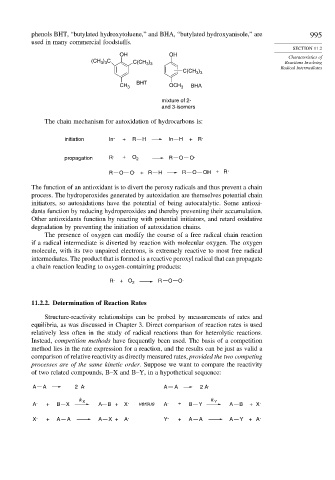Page 1011 - Advanced Organic Chemistry Part A - Structure and Mechanisms, 5th ed (2007) - Carey _ Sundberg
P. 1011
phenols BHT, “butylated hydroxytoluene,” and BHA, “butylated hydroxyanisole,” are 995
used in many commercial foodstuffs.
SECTION 11.2
OH OH Characteristics of
(CH ) C C(CH ) Reactions Involving
3 3
3 3
Radical Intermediates
C(CH )
3 3
BHT
CH 3 OCH 3 BHA
mixture of 2-
and 3-isomers
The chain mechanism for autoxidation of hydrocarbons is:
. .
initiation In + R H In H + R
propagation R . + O 2 R O O .
R O O . + R H R O OH + R .
The function of an antioxidant is to divert the peroxy radicals and thus prevent a chain
process. The hydroperoxides generated by autoxidation are themselves potential chain
initiators, so autoxidations have the potential of being autocatalytic. Some antioxi-
dants function by reducing hydroperoxides and thereby preventing their accumulation.
Other antioxidants function by reacting with potential initiators, and retard oxidative
degradation by preventing the initiation of autoxidation chains.
The presence of oxygen can modify the course of a free radical chain reaction
if a radical intermediate is diverted by reaction with molecular oxygen. The oxygen
molecule, with its two unpaired electrons, is extremely reactive to most free radical
intermediates. The product that is formed is a reactive peroxyl radical that can propagate
a chain reaction leading to oxygen-containing products:
R . + O 2 R O O .
11.2.2. Determination of Reaction Rates
Structure-reactivity relationships can be probed by measurements of rates and
equilibria, as was discussed in Chapter 3. Direct comparison of reaction rates is used
relatively less often in the study of radical reactions than for heterolytic reactions.
Instead, competition methods have frequently been used. The basis of a competition
method lies in the rate expression for a reaction, and the results can be just as valid a
comparison of relative reactivity as directly measured rates, provided the two competing
processes are of the same kinetic order. Suppose we want to compare the reactivity
of two related compounds, B–X and B–Y, in a hypothetical sequence:
A A 2 A . A A 2 A .
A . + B X k X A B + X . versus A . + B Y k Y A B + X .
. . . .
X + A A A X + A Y + A A A Y + A

